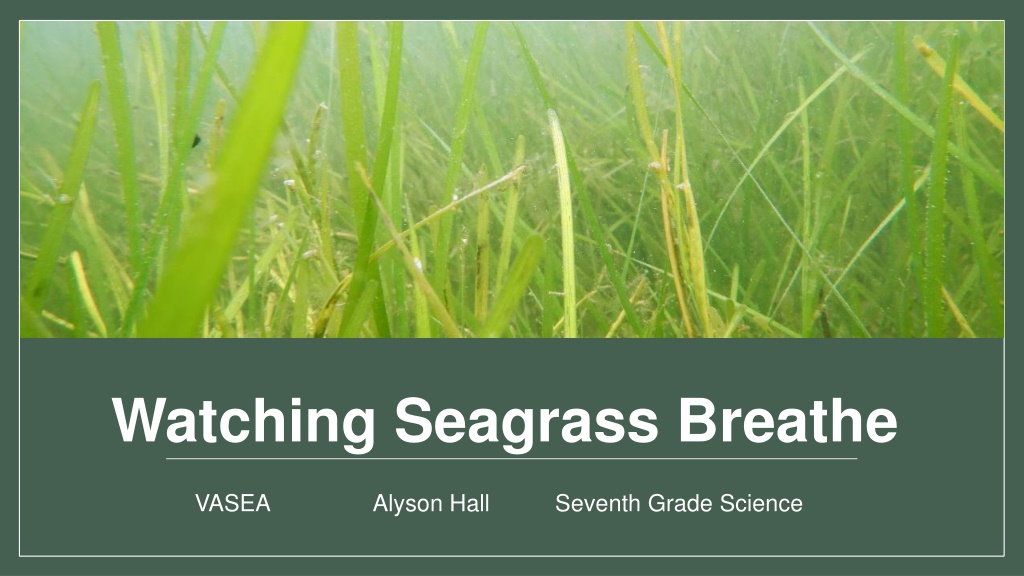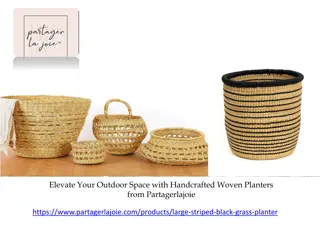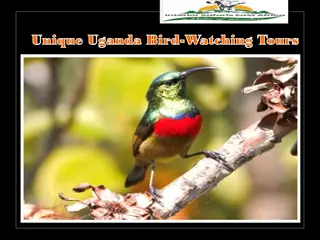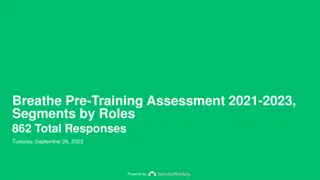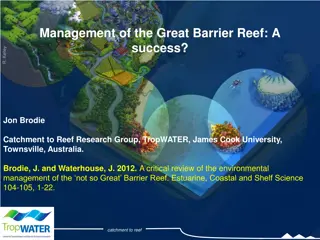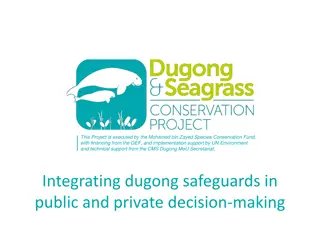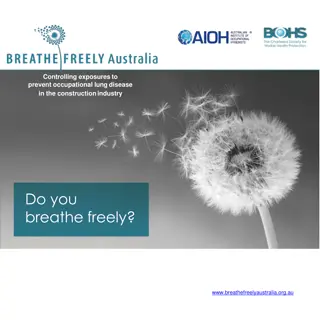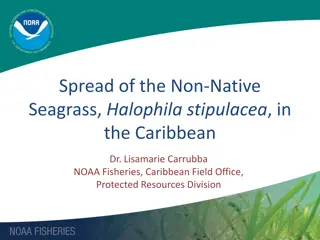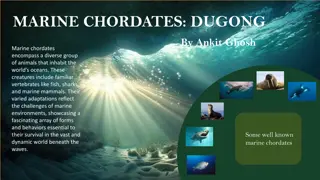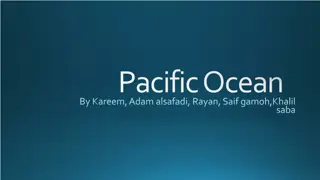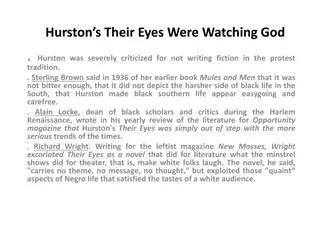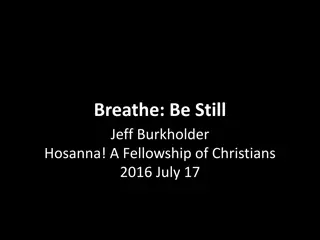Watching Seagrass Breathe
Join marine biologist Alyson Hall in her seventh-grade science project to study seagrass ecosystems. Discover the importance of seagrasses, the differences between seagrasses and seaweeds, and the two species of seagrass found in the Chesapeake Bay. Engage in activities like surveying seagrass, measuring dissolved oxygen, and calculating rates of respiration and primary production. Explore the fascinating world of marine angiosperms and understand their role in coastal and ocean environments.
Download Presentation

Please find below an Image/Link to download the presentation.
The content on the website is provided AS IS for your information and personal use only. It may not be sold, licensed, or shared on other websites without obtaining consent from the author. Download presentation by click this link. If you encounter any issues during the download, it is possible that the publisher has removed the file from their server.
E N D
Presentation Transcript
Watching Seagrass Breathe VASEA Alyson Hall Seventh Grade Science
Meet the Scientist Hello! My name is Aly I am a marine biologist, I study living things on the coast and in the ocean. I like to scuba dive and work with plants and animals that live in the ocean Ever since I was little, I wanted to work on the ocean Photos by Alyson Hall
Goals for Today Marine scientists measure the primary production of seagrass to help understand if seagrass meadows are putting energy and oxygen into the system. To do this we have two main goals: Survey the seagrass and collect data on the dissolved oxygen 1. Use that data to calculate rates of respiration and primary production 2. Photo by Alyson Hall
What are Seagrasses? Seagrasses are marine angiosperms. Marine means they live in saltwater, like the ocean or estuaries Angiosperms is a word for flowering plants like fruit trees or flowers! There are many species of seagrasses that are the ancestors of different plants on land that moved in the ocean. Can you think of some green things that live in the ocean? Are these seagrasses? Photo by Alyson Hall
Seagrasses vs Seaweeds Seagrasses and Seaweeds may look similar, but they are different! Seagrasses have true leaves, but seaweeds have blades 1. Seagrasses reproduce with seeds, but seaweeds reproduce with microscopicspores 2. Seagrasses have roots that go in the sediment, but seaweeds have holdfasts to hold onto rocks 3. But BOTH photosynthesize! 4. Tracey Saxby, Integration and Application Network (ian.umces.edu/media-library)
The Chesapeake Bay Has Two Species of Seagrass The Chesapeake Bay has two species of seagrass: Eelgrass Zostera marina Widgeon Grass Ruppia maritima These two species differ in size and shape Eelgrass is taller with thicker leaves Widgeon grass is usually shorter with thin, branching leaves Eelgrass Widgeon Grass Tracey Saxby and Jane Thomas, Integration and Application Network (ian.umces.edu/media-library)
Can You Guess Which Picture is Each Species? Photos by Alyson Hall
Can You Guess Which Picture is Each Species? Eelgrass! Widgeon Grass! Photos by Alyson Hall
Why Care About Seagrasses? Seagrasses form seagrass meadows, which are important ecosystems! Seagrass meadows: Provide homes for many animals Keep sediment in place from waves Provide food for the rest of the food web Put oxygen into the water in many areas! Photo by Alyson Hall
Why Care About Seagrasses? Seagrasses form seagrass meadows, which are important ecosystems! We are going to focus on their ability to put oxygen in the water through primary production! Seagrass meadows: Provide homes for many animals Keep sediment in place from waves Provide food for the rest of the food web Put oxygen into the water in many areas! Photo by Alyson Hall
Primary Production and Respiration Plants are primary producers! Plants create their own food (sugars) from: Energy from sunlight Water Carbon Minerals. We and other animals are consumers. Weeat other organisms (like plants or animals) for energy Photo by Alyson Hall
Primary Production and Respiration Plants are primary producers! Plants create their own food (sugars) from: Energy from sunlight Water Carbon Minerals. We and other animals are consumers. Weeat other organisms (like plants or animals) for energy But just like us, plants don t only make food, but they use food for energy => Respiration Photo by Alyson Hall
Why Do Scientists Want to Measure Primary Production? All organisms need to use energy from food to live We get energy from cellular respiration Using food to create energy needed for living Primary producers like plants in ecosystems such as forests or seagrass meadows are the start of food for whole food web By knowing how productive an ecosystem is, we learn a lot about everything that lives in that ecosystem. Photo by Alyson Hall
How Do Scientists Measure Primary Production? Plant primary production comes from photosynthesis We want to know how much energy is produced, but it is hard to measure that! So can measure oxygen to indirectly measure primary production. With light: Carbon dioxide + Water Sugar + Oxygen Carbon Dioxide 6??2+ 6?2? ?6?12?6+ 6?2 Water We can measure changes in dissolved oxygen underwater using sensors! Oxygen Sugar Tracey Saxby, Integration and Application Network (ian.umces.edu/media-library)
Photo by Alyson Hall Scientists in Benthic Chambers to Measure Primary Production We put an oxygen sensor in the benthic chamber and let the chamber run an incubation (time it measures). Benthic chambers trap the water so we can measure chnages in oxygen in a certain spot! This is me setting up one of my chambers! Tracey Saxby, Integration and Application Network (ian.umces.edu/media-library)
Photo by Alyson Hall Scientists in Benthic Chambers to Measure Primary Production We put an oxygen sensor in the benthic chamber and let the chamber run an incubation (time it measures). Benthic chambers trap the water so we can measure chnages in oxygen in a certain spot! But what about respiration? Plants undergo aerobic respiration, meaning they use oxygen for respiration like we do! This is me setting up one of my chambers! Tracey Saxby, Integration and Application Network (ian.umces.edu/media-library)
We Use Dark and Light Chambers to Measure Respiration and Net Primary Production The light chambers allow in light so they measure Net Primary Production! The seagrasses are both respiring ( - oxygen) and photosynthesizing ( + oxygen) The black chambers block out light so they measure respiration only (- oxygen) Photo by Alyson Hall Tracey Saxby, Integration and Application Network (ian.umces.edu/media-library)
We Use Dark and Light Chambers to Measure Respiration and Net Primary Production The light chambers allow in light so they measure Net Primary Production! The seagrasses are both respiring ( - oxygen) and photosynthesizing ( + oxygen) If we subtract these two rates we can estimate the Gross Primary Production*. The black chambers block out light so they measure respiration only (- oxygen) *This is the total amount of primary production before the plants respire and use energy and oxygen! Tracey Saxby, Integration and Application Network (ian.umces.edu/media-library)
We Use Dark and Light Chambers to Measure Respiration and Net Primary Production The light chambers allow in light so they measure Net Primary Production! The seagrasses are both respiring ( - oxygen) and photosynthesizing ( + oxygen) If we subtract these two rates we can estimate the Gross Primary Production*. The black chambers block out light so they measure respiration only (- oxygen) *This is the total amount of primary production before the plants respire and use energy and oxygen! Photo by Alyson Hall Tracey Saxby, Integration and Application Network (ian.umces.edu/media-library)
Calculating Gross Primary Production (GPP) Photosynthesis produces oxygen The concentration of oxygen in the light chambers will increase* => A positive rate (Ex: 20 units of Oxygen per minute)! *But light chambers are also measuring respiration because the plants don t stop respiring. Respiration uses oxygen The concentration of oxygen in dark chambers will go down => A negative rate (Ex: -10 units of Oxygen per minute)! => (Rate from Light Chambers) (Rate from Dark Chambers) = Gross Primary Production! => (+20 units per minute) (-10 units per minute) = 30 units per minute! Remember subtracting a negative will cancel out the negative and minus!
Gross Primary Production can tell us if seagrass meadows are putting extra energy and oxygen into the system. What does a positive rate of GPP mean? What does a negative rate of GPP mean? Photo by Alyson Hall
Gross Primary Production can tell us if seagrass meadows are putting extra energy and oxygen into the system. What does a positive rate of GPP mean? => that photosynthesis is creating more energy and oxygen than the plant uses from respiration. This means the seagrass meadow is Net Autotrophic = makes extra energy What does a negative rate of GPP mean? => that photosynthesis is not creating enough energy and oxygen for the plant. This means the seagrass meadow is Net Heterotrophic = uses more energy than it makes! Photo by Alyson Hall
Now Its Your Turn! 1. You are going to count oxygen bubbles just like the oxygen sensors do for both light and dark chambers. 2. Then you will calculate rates of respiration and net primary production (NPP) 3. You will use those rates to estimate the rate of Gross Primary Production (GPP) for seagrasses in the Chesapeake Bay! Tracey Saxby, Integration and Application Network (ian.umces.edu/media-library)
Now Its Your Turn! 1. You are going to count oxygen bubbles just like the oxygen sensors do for both light and dark chambers. 2. Then you will calculate rates of respiration and net primary production (NPP) 3. You will use those rates to estimate the rate of Gross Primary Production (GPP) for seagrasses in the Chesapeake Bay! Remember! You are measuring rates because it is a change in oxygen over a time period (the chamber incubation!) Tracey Saxby, Integration and Application Network (ian.umces.edu/media-library)
Species Dont Always Behave the Same! Remember that the Chesapeake Bay has two species of seagrass! These species differ in shape and size These species have different communities of animals that live in them too Will they have the same rate of NPP, respiration, and GPP? Eelgrass Widgeon Grass Tracey Saxby and Jane Thomas, Integration and Application Network (ian.umces.edu/media-library)
Scientists Often Scale Up Measurements to Estimate Whole Ecosystems Our chambers only ran for 1 hour and covered about one square foot of bottom. Scientists want to know about how entire seagrass meadows or entire estuaries function for whole days, weeks, or years. How can we scale up our small samples to make these estimates? Photo by Alyson Hall
The Amount of Seagrass in the Chesapeake Bay Changes Yearly The shades of green show how dense the seagrass is from sparse (light green) to very dense (dark green) Graph from the Virginia Institute of Marine Science
The Amount of Each Species is Also Changing in the Chesapeake Bay Yearly Black = All Aquatic Plants Green = Widgeon Grass Blue = Eelgrass Graph from the Virginia Institute of Marine Science
Why Does Seagrass Coverage Change Yearly? Why Do Species Change Differently? Photos by Alyson Hall
Why Does Seagrass Coverage Change Yearly? => Seagrass coverage can be impacted by many factors: Things that affect production and respiration Temperature, light, carbon dioxide concentrations Humans Boat scaring from propellers Aquaculture Harmful Algae Blooms, more herbivores, and more! Why Do Species Change Differently? => Different species will react to each of these factors differently, leading to different coverages. For example, Eelgrass is less heat tolerant than Widgeon Grass which has lead to it s decline! Photos by Alyson Hall
What Did We Learn Today? Seagrasses are really important primary producers in the Chesapeake Bay The two species of seagrass do not have the same rates of NPP, respiration, and GPP Scientists use small chambers as a sample to estimate processes for much larger areas and time Seagrasses and the GPP they provide is decreasing in the Chesapeake Bay and the dominance of species is changing! Photo by Alyson Hall
